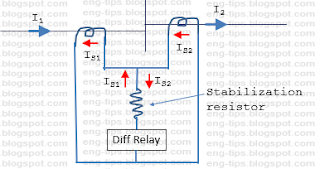Introduction: In earlier post we have discussed about Bus bar differential protection.
For Low impdance bus bar protections, different manuafacturer use different algorithm to avoid mal-operation of relay during CT saturation.
Phase comparison technique: One of the method is use of Phase comparison technique for detecting internal / external faults. Phase comparison function compares the phase-angles of the fundamental components of all the feeder currents.
During a through-fault, at least one of the currents is ~180° out of phase with the others. In case of CT saturation its magnitude may be lower but relay can compare its angle to distinguish internal fault from external fault.
During internal fault of bus bar, currents from all feeders will flow towars busbar. This means, phase angle of all currents will be nearly same.
If the phase-angles of all the feeder currents of a protection zone lie within a band of ~74° (typical value), the phase comparison function decides that there is an internal fault.
For proper operation, it is necessary to exclude feeders conducting very little or no current from the comparison to prevent noise generated by them.
A minimum current is therefore determined below which a feeder is excluded from the phase comparison. Typical settings are 0.8 IN for the phase currents and 0.25 IN for the neutral current.
Tripping only takes place if the differential current and the stability factor (Slope) are both above their pick-up settings and the phase difference between the currents is less than setting.








